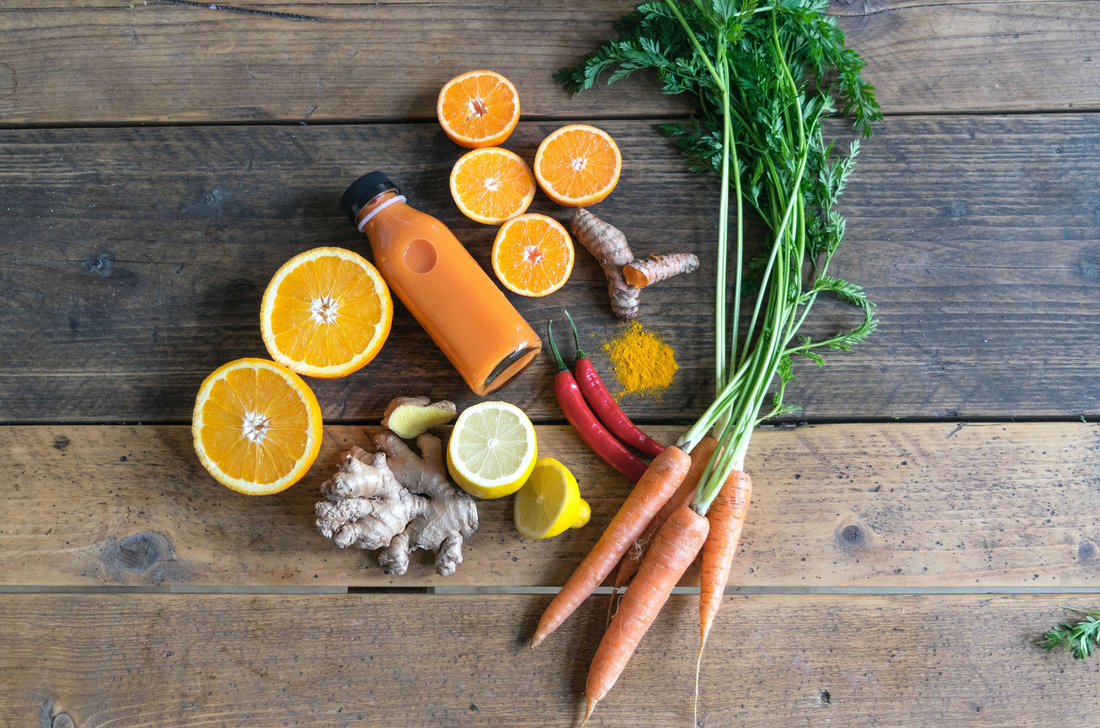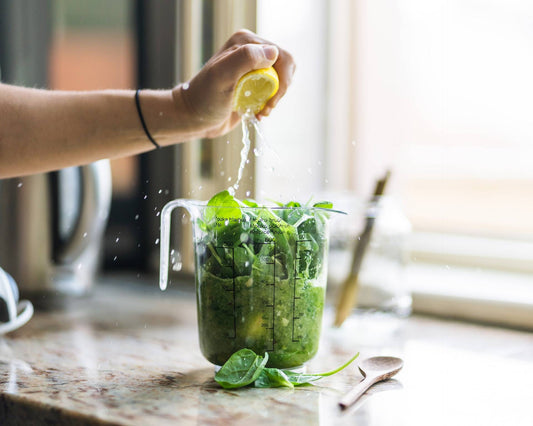

Today I’m sharing another one of my favorite recipes for gut health! A ginger bug is a natural fermentation starter made from ginger, sugar, and water. It captures wild yeasts and beneficial bacteria present on the ginger to create a fizzy, probiotic-rich liquid. The ginger bug acts as a natural culture to kickstart the fermentation process in homemade probiotic beverages like ginger ale or tea. Minus all the toxic ingredients found in regular soda!
The probiotic qualities support microbiome health, better digestion, and immune health.
Ginger Bug Recipe for Gut Health
Ingredients:
- 1 ounce of fresh organic ginger, grated or finely chopped (with the skin on)
- 1 Small cube of turmeric
- 2 teaspoons of sugar (I use one teaspoon of organic unbleached sugar and 1 teaspoon of date sugar. Avoid using alternative sweeteners as they may contain antimicrobial properties that can inhibit fermentation)
- 2 cups of filtered, chlorine-free water (don’t use tap water, which will interfere with the fermentation process)
Instructions:
- Combine ginger and sugar: In a clean glass mason jar, add the grated or finely chopped ginger and the sugar.
- Add water: Pour the filtered water into the jar, covering the ginger and sugar. Shake well to dissolve the sugar.
- Cover the jar: secure it well. This allows air to flow in and out while preventing debris from getting into the jar. Let it sit for 24 hours.
- Daily feeding: Over the next several days, once every 24 hours, add one knob of ginger and one teaspoon of sugar to the jar. Stir well to mix in the new ingredients.
- Observe fermentation: You should start seeing bubbles forming within the first couple of days. This indicates that the wild yeasts and beneficial bacteria from the ginger are starting to ferment the sugar-water mixture.
- Continue feeding: Keep feeding the ginger bug daily for about 4 to 7 days or until it becomes fizzy and active. The time it takes to become bubbly can vary depending on the ambient temperature and the wild microorganisms present in your environment.
- Test readiness: To check if your ginger bug is ready, do the "float test." Take a small spoonful of the ginger bug and drop it into a glass of water. If it floats, it's active and ready to be used in your fermented beverages.
- Store the ginger bug: At this point, you can transfer the ginger bug to the refrigerator. Feed it once a week with one tablespoon of grated ginger and one tablespoon of sugar to keep it alive and active.
To use your ginger bug as a fermentation starter for homemade probiotic beverages like ginger ale or fizzy tea, simply add some of the ginger bug (strained from the liquid) to water. Allow this mixture to ferment at room temperature for a day or two until it reaches your desired level of fizziness. Then, strain and refrigerate the homemade probiotic drink before serving. Or if you don’t want to wait, you can just mix a few tablespoons or ¼ cup of the bug with your tea or water without waiting.
Do you wash ginger for ginger bug?
It is generally recommended to use unwashed organic ginger for making a ginger bug. Organic ginger is less likely to contain any residual chemicals or pesticides that could interfere with the fermentation process. The skin of the ginger is also believed to harbor the wild yeasts and bacteria necessary for fermentation. Washing the ginger could potentially remove these beneficial microorganisms, which are essential for creating a successful ginger bug.
What does ginger bug smell like?
As the ginger bug ferments, it will develop a distinct aroma. In the early stages of fermentation, it may have a fresh and slightly sweet scent with hints of ginger. As the fermentation progresses, the ginger bug will become more pungent and tangy due to the production of carbon dioxide and the activity of the fermenting microorganisms.
As the ginger bug ferments, it will develop a distinct aroma. In the early stages of fermentation, it may have a fresh and slightly sweet scent with hints of ginger. As the fermentation progresses, the ginger bug will become more pungent and tangy due to the production of carbon dioxide and the activity of the fermenting microorganisms.
Enjoy your ginger bug, and for more gut health recipes, be sure to check out our YouTube Channel where I share all my favorites!
With gratitude,

 Martha Carlin, is a “Citizen Scientist”,
systems thinker, wife of Parkinson’s warrior, John Carlin, and founder of The BioCollective , a microbiome company expanding
the reach of science and BiotiQuest, the first of it’s kind probiotic line. Since John’s diagnosis in 2002,
Martha began learning the science of agriculture, nutrition, environment, infectious disease, Parkinson’s
pathology and much more. In 2014, when the first research was published showing a connection between the gut
bacteria and the two phenotypes of Parkinson’s, Martha quit her former career as a business turnaround expert
and founded The BioCollective to accelerate the discovery of the impact of gut health on all human disease. Martha was a speaker at the White House 2016 Microbiome Initiative launch, challenging the scientific
community to “think in a broader context”. Her systems thinking background and experience has led to collaborations
across the scientific spectrum from neuroscience to engineering to infectious disease. She is a respected out of the
box problem solver in the microbiome field and brings a unique perspective to helping others understand the
connections from the soil to the food to our guts and our brains.
Martha Carlin, is a “Citizen Scientist”,
systems thinker, wife of Parkinson’s warrior, John Carlin, and founder of The BioCollective , a microbiome company expanding
the reach of science and BiotiQuest, the first of it’s kind probiotic line. Since John’s diagnosis in 2002,
Martha began learning the science of agriculture, nutrition, environment, infectious disease, Parkinson’s
pathology and much more. In 2014, when the first research was published showing a connection between the gut
bacteria and the two phenotypes of Parkinson’s, Martha quit her former career as a business turnaround expert
and founded The BioCollective to accelerate the discovery of the impact of gut health on all human disease. Martha was a speaker at the White House 2016 Microbiome Initiative launch, challenging the scientific
community to “think in a broader context”. Her systems thinking background and experience has led to collaborations
across the scientific spectrum from neuroscience to engineering to infectious disease. She is a respected out of the
box problem solver in the microbiome field and brings a unique perspective to helping others understand the
connections from the soil to the food to our guts and our brains.


Waking Up to a Probiotic Breakfast Can Do Wonders for Your Gut Health
Did you know that recent studies show people with poor gut diversity had lower quality of life? The health of your microbiome impacts your mental health, sleep, energy, the risk for chronic illnesses, and much more. A probiotic breakfast can...

Can Probiotic Supplements Make or Break Your Fast?
Intermittent fasting (IF) may have started as a fitness trend for weight loss, but today it's a go-to lifestyle choice for many. Practicing intermittent fasting has been linked with health benefits such as lowering blood sugar and insulin, preventing heart...














 Martha Carlin
Martha Carlin








